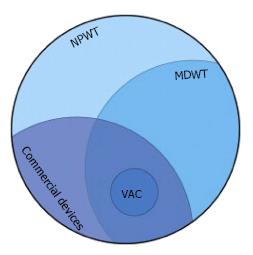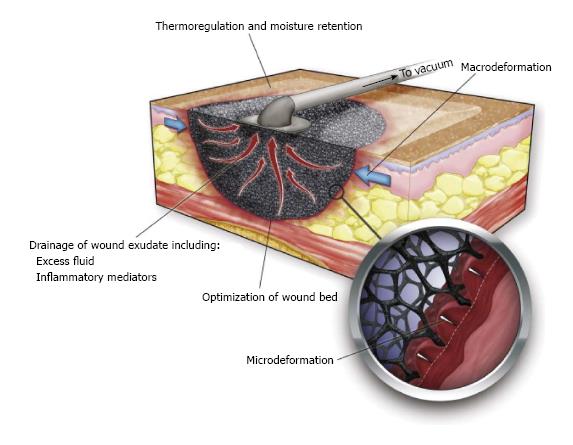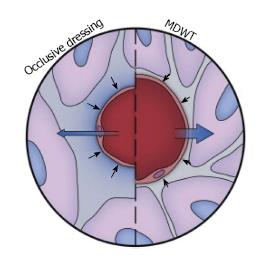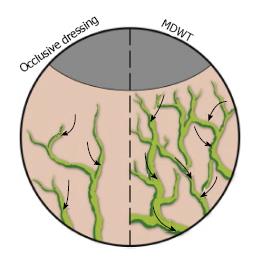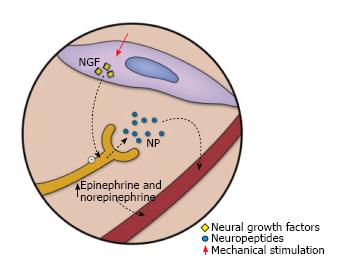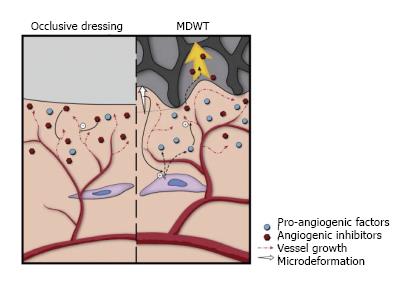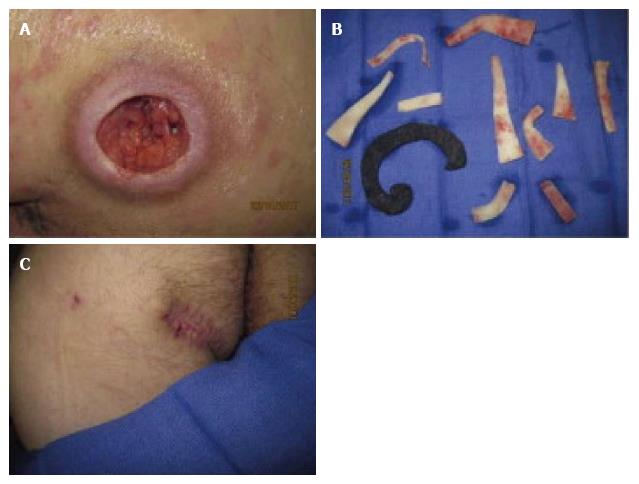Copyright
©The Author(s) 2017.
Figure 1 Visual representation of the definitions used in this article[2].
Negative pressure wound therapy (NPWT) defines the entire field of wound therapy that applies differential suction to the wound. Microdeformational wound therapy (MDWT) refers specifically to the field as applied to the science of the foam wound interface that causes deformation. The Vacuum-assisted closure (VAC) therapy system is the most commonly used commercially available device. Reproduced from, Huang C, Leavitt T, Bayer LR, Orgill DP. Effect of negative pressure wound therapy on wound healing. Curr Probl Surg 2014; 51: 301-331. Copyright 2016 by Elsevier.
Figure 2 The 4 primary mechanisms of microdeformational wound therapy: (1) macrodeformation; (2) microdeformation (3) fluid removal; and (4) alteration of the wound environment[2].
Reproduced from, Huang C, Leavitt T, Bayer LR, Orgill DP. Effect of negative pressure wound therapy on wound healing. Curr Probl Surg 2014; 51: 301-331. Copyright 2016 by Elsevier.
Figure 3 Removal of edema results in decreased hydrostatic compression of the capillaries and, hence, reduction of the required diffusion distance[2].
The overall increase in tissue perfusion optimises wound healing. MDWT: Microdeformational wound therapy. Reproduced from, Huang C, Leavitt T, Bayer LR, Orgill DP. Effect of negative pressure wound therapy on wound healing. Curr Probl Surg 2014; 51: 301-331. Copyright 2016 by Elsevier.
Figure 4 Lymphatic drainage is promoted though gradual increase in the density of the lymphatics at the wound edges[2].
MDWT: Microdeformational wound therapy. Reproduced from, Huang C, Leavitt T, Bayer LR, Orgill DP. Effect of negative pressure wound therapy on wound healing. Curr Probl Surg 2014; 51: 301-331. Copyright 2016 by Elsevier.
Figure 5 Microdeformational wound therapy promotes neurogenesis via upregulation of substance P, neurotrophin nerve growth factor, and calcitonin gene-related peptide[2].
Plasma epinephrine and norepinephrine are also transiently elevated. Reproduced from, Huang C, Leavitt T, Bayer LR, Orgill DP. Effect of negative pressure wound therapy on wound healing. Curr Probl Surg 2014; 51: 301-331. Copyright 2016 by Elsevier.
Figure 6 Angiogenesis is stimulated via several mechanisms, including microdeformation, upregulation of proangiogenic factors and removal of inhibitory factors[2].
MDWT: Microdeformational wound therapy. Reproduced from, Huang C, Leavitt T, Bayer LR, Orgill DP. Effect of negative pressure wound therapy on wound healing. Curr Probl Surg 2014; 51: 301-331. Copyright 2016 by Elsevier.
Figure 7 Instillation vacuum-assisted closure[2].
Fluid, such as normal saline, is instilled into the wound through a port on the connecting tube to enhance wound healing. Reproduced from, Huang C, Leavitt T, Bayer LR, Orgill DP. Effect of negative pressure wound therapy on wound healing. Curr Probl Surg 2014; 51: 301-331. Copyright 2016 by Elsevier.
Figure 8 Infection and sepsis, foam retention in the wound, tissue adherence, bleeding, and pain[2].
A: Treatment of L-1 partial paralysis and left ischial pressure ulcer with microdeformational wound therapy for 2 m; B: Discovery of retained foam; C: Wound healing following removal of foreign material and flap surgery. Courtesy of Brigham and Women's Hospital.
- Citation: Panayi AC, Leavitt T, Orgill DP. Evidence based review of negative pressure wound therapy. World J Dermatol 2017; 6(1): 1-16
- URL: https://www.wjgnet.com/2218-6190/full/v6/i1/1.htm
- DOI: https://dx.doi.org/10.5314/wjd.v6.i1.1









